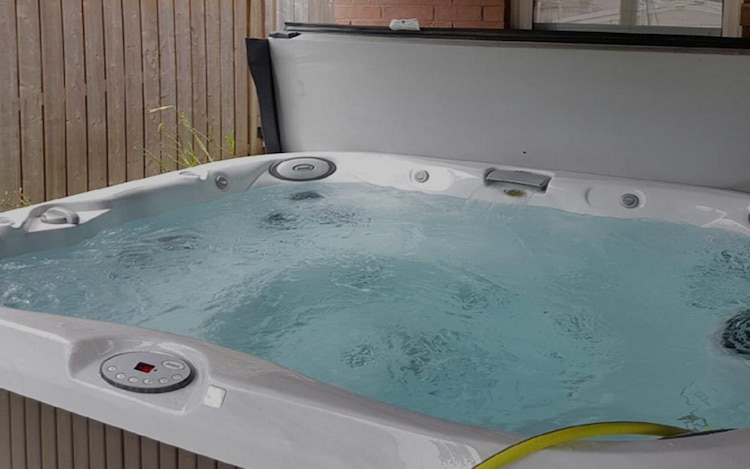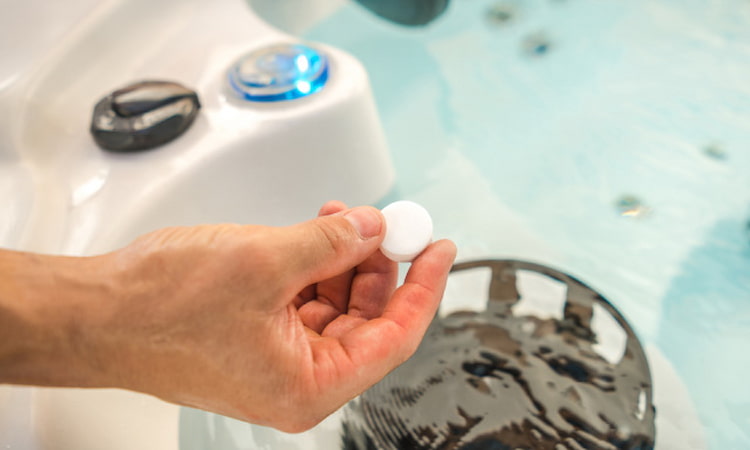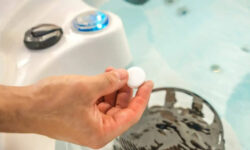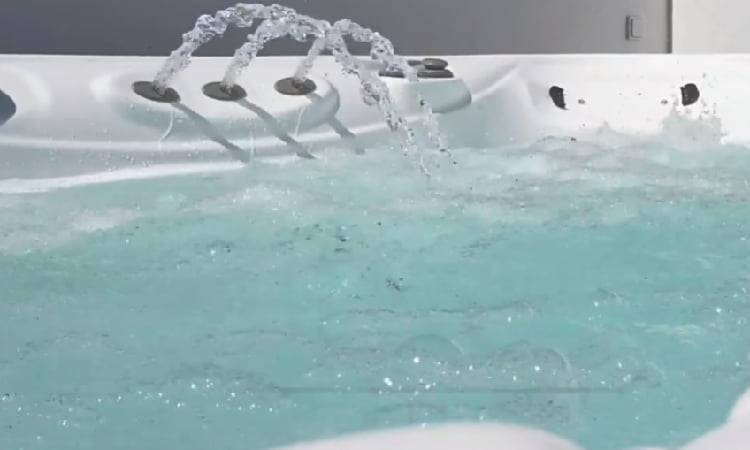Ever wondered what’d happen if you put bleach in your hot tub? You’re not alone. Many believe it’s an easy fix for murky water.
Adding bleach to a hot tub can help in disinfecting the water. However, it’s not recommended due to its high concentration of chlorine which can damage the tub’s lining and components. It can also cause skin and eye irritation if the concentration is too high.
So before you start pouring, it’s important to understand the chemical reactions involved, the potential damage to your tub, and the health risks you could face.

Quick Navigation
The Chemical Reactions of Bleach in Hot Tubs
When you add bleach to your hot tub, you’re initiating a series of chemical reactions that can significantly alter the water’s composition.
Here’s how it works: Bleach contains chlorine, a powerful oxidizer. When it’s introduced into your hot tub’s water, it reacts with a substance known as hypochlorous acid, creating a potent disinfectant effective against harmful bacteria and algae.
However, when this reaction occurs, it also changes the water’s pH level, making it more alkaline. This shift can be harmful to your skin and eyes, causing irritation and discomfort. Plus, it can also corrode your hot tub’s internal components over time if the water isn’t properly balanced.
You’re also creating a byproduct called chloramine when you add bleach. This chemical is responsible for that strong, unpleasant ‘chlorine’ smell. It’s less effective as a disinfectant and can cause respiratory issues if inhaled in large amounts.
Therefore, while bleach can be a quick fix for sanitizing your hot tub, it’s not without its drawbacks.
Impact of Bleach on Hot Tub Components
By using bleach in your hot tub, you’re potentially damaging its components, leading to costly repairs or replacement parts down the line.

Bleach is a potent chemical that can corrode vital parts of your hot tub, such as the heater, pump, and jet components. Corrosion degrades these parts over time, decreasing their efficiency and eventually causing them to fail.
Moreover, bleach can deteriorate the tub’s acrylic shell and vinyl lining, causing discoloration and cracks. It’s also harmful to your hot tub’s filtration system. It can clog the filter, reducing its ability to clean the water and potentially causing it to malfunction.
Additionally, bleach can disrupt the water’s pH balance. If you’re consistently using bleach, you’ll find yourself frequently needing to adjust the water’s pH, which can be a nuisance.
Lastly, bleach can degrade the hot tub cover. The harsh chemical can weaken the vinyl, causing it to become brittle and crack. This diminishes the cover’s effectiveness at maintaining the water temperature and keeping out debris.
Health Risks Associated With Using Bleach in Hot Tubs
Not only are there several health risks you’ll face if you use bleach in your hot tub, but these can also be serious and long-lasting.
Bleach contains chlorine, a strong oxidizer that can irritate or even burn your skin and eyes. Over time, chronic exposure can lead to more severe conditions like dermatitis or even respiratory problems.
In addition, bleach’s high pH can disrupt your hot tub’s balance, making the water harsh and uncomfortable. This can cause further irritation to your skin and eyes, as well as potentially causing damage to your hair. Prolonged exposure might lead to more serious issues, such as bacterial infections due to micro-tears in your skin caused by the harsh environment.
Lastly, if bleach is used in high concentrations, it can produce toxic gases when heated, posing a risk of respiratory distress or even poisoning. It’s also worth noting that mixing bleach with other chemicals commonly found in hot tubs, such as bromine, can produce dangerous reactions.
Related Read: How to Lower Bromine Level in Hot Tub?
Alternatives to Bleach for Hot Tub Maintenance

You’ll find a number of alternatives for bleach in hot tub maintenance, and these can effectively keep your tub clean without posing the same risks.
One popular option is bromine. It’s a chemical sanitizer similar to chlorine but less harsh on your skin and eyes. It’s also more stable at high temperatures, making it ideal for hot tubs.
Another good choice is Biguanide. It’s a non-chlorine, non-bromine sanitizer that’s gentle on the skin and doesn’t produce any strong odors. It’s a bit more expensive, but it’s effective and easy to use.
You might also consider mineral sanitizers. These use minerals like silver and copper to kill bacteria and algae. They’re natural and less irritating to the skin and eyes. You’ll still need to use a small amount of bromine or chlorine, but far less than you would otherwise.
Lastly, there’s ozone. An ozonator uses electricity to create ozone gas, which kills bacteria and viruses. It’s a powerful sanitizer that reduces the need for other chemicals.
Frequently Asked Questions
When you add bleach to hot tub water, it immediately reacts, potentially causing harmful chlorine gas. It’s also corrosive, so it can damage your tub’s components. It’s not a recommended cleaning method.
If you’re using bleach in your hot tub, you should change the water every three months. However, this can vary based on usage and water quality. Always test your water regularly to ensure it’s safe.
To correctly add bleach to your hot tub, you’ll dilute it first. Always add it when the tub’s not in use. Stir it well, and test the water before using the tub. Safety is crucial here.
Yes, it does. Higher water temperatures can cause the bleach to evaporate quicker, reducing its sanitizing efficacy. You’ll need to adjust the bleach quantity accordingly to maintain a safe and balanced hot tub environment.
If you use bleach in your hot tub, it can degrade your tub’s cover over time. The bleach’s corrosive nature can weaken the cover’s material, reducing its lifespan and effectiveness. It’s best to avoid it.
Conclusion
In conclusion, using bleach in your hot tub isn’t advisable. The chemical reactions can damage your tub’s components and pose health risks. Instead of bleach, consider safer alternatives for maintaining your tub.
Remember, many have learned the hard way that bleach and hot tubs don’t mix. Keep your tub clean and safe without resorting to potentially harmful methods.

![What is a Stabilizer in a Hot Tub? [Types of Stabilizers] what is a stabilizer in hot tubs and how does it work](https://hottubtales.com/wp-content/uploads/2023/10/what-is-a-stabilizer-in-hot-tubs-and-how-does-it-work-250x150.jpg)



![Can You Over Shock a Hot Tub? [What to Do if You Did?] can you over shock a hot tub](https://hottubtales.com/wp-content/uploads/2023/10/can-you-over-shock-a-hot-tub-250x150.jpg)
